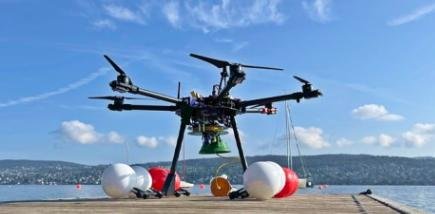1 of 2 | A new "dual robot" drone called MEDUSA can fly and dive to collect data on water quality in hard-to-reach areas like the Arctic. Photo courtesy of Aerial Robotics Lab/Imperial College London.
June 14 (UPI) -- A new "dual robot" drone that can fly and dive has successfully collected underwater samples to track water quality changes in hard-to-reach areas.
The drone, which was developed at Imperial College London and called MEDUSA or Multi-Environment Dual robot for Underwater Sample Acquisition, can fly and land on water while dropping a camera with sensors more than 33 feet deep to collect data and samples.
"MEDUSA is unique in its dual robot design, with a flight component that reaches difficult-to-access areas and a diving component that monitors water quality," said Mirko Kovac, department of aeronautics professor at Imperial College London. "Our drone considerably simplifies robotic underwater monitoring by performing challenging tasks which would otherwise require boats."
The drone was recently tested in laboratories and in field experiments on Lake Zurich in Switzerland.
Scientists plan to use the dual drone in areas inaccessible by boat to test waters for signs of microorganisms and algae blooms, which pose hazards to humans and animals. Researchers say the drone could also be used to maintain offshore infrastructure like underwater energy pipelines, as well as to measure temperature and salinity changes in the Arctic for global climate clues.
"We have much to learn about the Earth's water by monitoring ecological parameters we can identify trends and understand the factors affecting water quality and the health of the ecosystem in a changing climate," Kovac said.
MEDUSA is able to travel long distances with heavy payloads to reach remote water environments, such as the Arctic, and bring back data. While the aerial drone design is an industry standard, the underwater component is new.
"MEDUSA's unique ability to reach difficult places and collect aquatic images, samples and metrics will be invaluable for ecology and aquatic research and could support our understanding of local climate in difficult-to-access environments like the Arctic," Kovac said.















